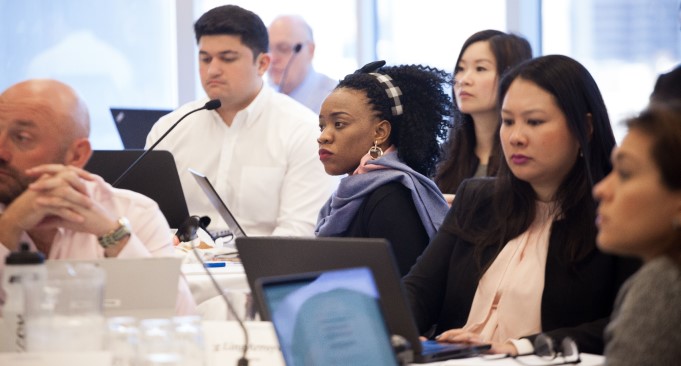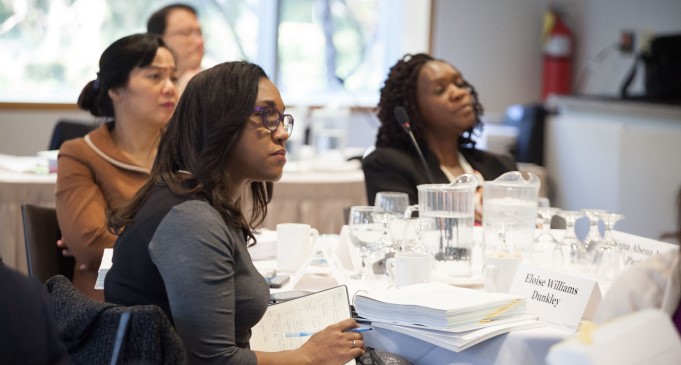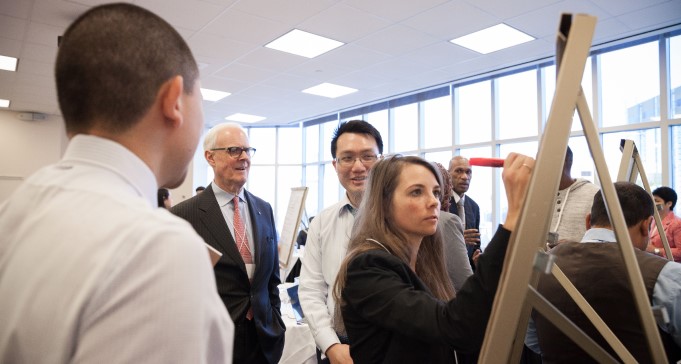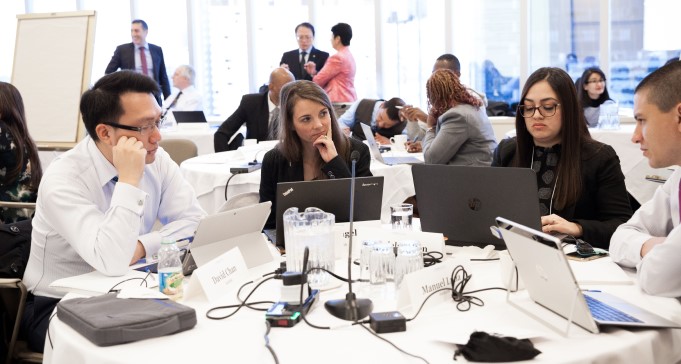Introduction and Overview[1]
In recent years, the term financial inclusion has become increasingly associated with digital financial services, and more particularly mobile money, with reference to financial inclusion initiatives in various countries, notably in Sub Saharan Africa and Southern Asia.
The lack of access to traditional financial services in these regions, combined with the increasingly widespread use of mobile phones, has given rise to a mobile phone-based economy in which mobile platforms are increasingly used as an alternative to traditional banking systems. Indeed, when M-pesa was launched in Kenya (East Africa) in 2007, only “one billion of the world’s 6.5 billion people had bank accounts yet at least three billion had mobile phones”[2].
Mobile money transfer services have become arguably the single most effective contributor to global financial inclusion initiatives, and, particularly in developing countries, have facilitated access to cheap and reliable financial services for an ever increasing formerly unbanked segment of the population.
Favourable regulatory environments and supervisory good practices have enabled significant innovation in mobile transfer services in various countries, thereby contributing to unprecedented success in financial inclusion initiatives. Indeed these have morphed into wider digital financial services ecosystems offering savings, insurance, local and international money transfers, payments and credit services on mobile money platforms, to both individuals and corporate entities.[3] There are over 270 deployments of mobile money globally, with 866 million mobile money accounts transacting US$ 1.3 billion daily in 2018; 45.6 % of which are in Sub Saharan Africa and 33.2% in Southern Asia.[4]
However, despite this success, achieving 100% financial inclusion where all have access to financial services is as yet an unfulfilled dream in many countries in these regions. Globally, about 1.7 billion adults currently remain unbanked and without access to safe, reliable and convenient financial services,[5] either through an account at a financial institution or through a mobile money provider. In 2014 that number was 2 billion.[6] Because account ownership is nearly universal in high-income economies, virtually all unbanked adults live in developing economies, mainly in Africa and South Eastern Asia. A significant percentage of these unbanked populations comprise women. For example, in 2014 more than 70% of women were financially excluded in Africa and there is a persistent gap between men and women when it comes to financial access, as illustrated by the figure below.
In a 2016 report, the GSMA estimated that 1.7 billion women in low- and middle-income countries do not own a mobile phone.[7]
Worldwide, there are various constraints and barriers that prevent women from accessing formal financial services. These include lower levels of education and income, lack of collateral, legal, time and mobility constraints as well as cultural constraints and an overall lack of gender parity, as discussed further below.
The objective of this TC Note is to explore measures that financial services regulators and supervisors can put in place to reduce or remove these constraints and barriers.
Benefits of Financial Inclusion for Women
The progress made in digital financial services has been heralded as one of the most important means to accelerate access to financial services for women.[8]
In particular, in areas where a large proportion of women were previously unbanked, access to financial services has significantly benefited women,[9] for example by enabling them to save and manage household expenditure and to improve food security, health care and the overall welfare of their families, thereby reducing poverty.
In contrast to male earnings, female controlled finances are more likely to be spent on household expenses, such as utilities and food, as well as on child welfare including school tuition and medical care. Financial security has in turn empowered women and given them a role in the decision-making process in their households.
Numerous studies have demonstrated that access to bank accounts and payment services are key to addressing today’s pressing global issues of poverty, inequality and migration and have a measurable impact on the reduction of poverty levels and promoting higher economic growth at a macro level. For individuals, greater financial inclusion can improve the economic and social aspects of life.
Additionally, access to useful and secure financial services has the potential to reduce hunger by empowering women and enabling them to improve their food security. As farmers, agricultural entrepreneurs and household caretakers, women are at the forefront of household food security and are essential to fighting hunger. Mobile money and other digital financial services have the potential to help women overcome the challenges they face when accessing and using financial services, particularly those related to mobility, time, safety and privacy.
Barriers to Women’s Financial Inclusion
There are various factors stifling progress in woman’s financial inclusion, the most critical being the impact of social norms, which are prevalent mainly in Africa, Asia, the Middle East and parts of Eastern Europe.
Social norms influence nearly every aspect of daily life, including financial services. They have an adverse impact on financial inclusion for women because they can limit women’s ability to work outside the home, engage with male agents, or even own a phone. Cultural norms around what is acceptable for a woman to do, where she can go alone, or with whom she can interact can all serve to limit women’s access to formal financial services.
Some common social norms and beliefs include:
- Women are primarily viewed as caregivers hence are confined to the home which also limits the scope of financial products they can access.
- Beliefs that women are not as financially savvy as men and must rely on their husbands/male relatives to make financial decisions and must therefore use joint bank accounts or their husband’s account. For example, in many Middle Eastern countries, opening an account requires approval from a male guardian.
- Societal beliefs that women should not own property or be involved in financial decisions. Some countries have enacted inheritance laws which favour men over women, reducing women’s access to family assets.
- Women are not expected to run businesses because doing so interferes with their primary responsibility of managing the household and looking after the family.
- Women cannot work in certain environments such as bars or restaurants, or in jobs which are typically held by men, and therefore have limited options for earning and saving money outside the house, which in turn makes it difficult for them to use formal financial services.
Other barriers to women’s financial inclusion include:
- Misplaced financial inclusion priorities: Policy makers may focus solely on closing the gender gap in account ownership as a means of empowering women, without addressing other important barriers and constraints.
- Restrictive regulatory requirements may result in unfavourable terms and conditions for opening accounts, for example Anti-money Laundering regulations on customer due diligence requirements to submit approved ID information. For example, in remote rural villages birth certificates – which are a prerequisite for obtaining an ID – are not normally obtained at birth as a matter of course. Requirements for business registration certificates and business references may also render women ineligible to open accounts and thus gain access to mobile banking services.
- Limited access to mobile phones can be a major barrier to digital financial inclusion, especially in rural areas. In most cases fewer women own phones than men. Additionally, even where they may have mobile phones, such phones may not be internet enabled, hence they cannot access some digital credit and other mobile financial services.
- Unavailability of credit and high costs of borrowing: Where women are not gainfully employed, they are more likely than men to be denied a loan or to pay higher interest rates as they will have a lower credit rating. Additionally, in circumstances where women hold accounts jointly with men, they may be unable to access their own formal savings accounts without the man’s approval, especially if his signature is required for withdrawals. As a result, women tend to rely on informal savings to finance their businesses or to buy essential farming inputs. This makes them vulnerable to liquidity constraints and price fluctuations, and they may be unable to establish SMEs.
- Reliance on informal savings and credit options: Unlike men who regularly use formal financial services, women tend to rely almost exclusively on informal options, such as voluntary savings and loan associations, money lenders, family and friends. Women’s dependence on informal finance may make it harder for them to access financial products that informal providers do not offer, such as insurance, digital credit and long-term loans. This, in turn, limits their financial options to make important investments and improve livelihood management strategies or diversify their income portfolios.
- Limited physical access to financial services: Where banks and mobile money agent outlets are too far away, there will be a tendency for women to keep money in their houses or on their persons, rather than open an account.
- Financial literacy: The inability to use an English-language phone or other digital service menu or the unavailability of a menu in an understandable language, the lack of financial numeracy skills, and the perception by low income people that some products such as mobile financial services are too complicated for them to understand, act as barriers to the adoption of these products and services and discourage low income or rural people from accessing digital financial services such as mobile money.
- Fraud and data privacy risks: Women who rely on agents or male family members to help them to make financial transactions run the risk of exposing themselves to security and fraud risks, and lose the privacy and security of keeping the cash themselves.
- Poverty and un-availability of sufficient cash/income to enable saving: In some emerging economies a significant percentage of the population are living below the poverty line and their immediate priority is to have enough money to meet their basic needs. Women form a greater percentage of the financially excluded segment as they do not work, or otherwise work in informal jobs where the salaries are low and often less than the prescribed minimum wage.
- Lack of formal education: Women with no formal education (primary, secondary and university education) are more likely to be financially excluded than those at the top of the education ladder. Education defines livelihood, wealth and the need for innovative financial services.
- Difficulties in identifying excluded women: Household surveys are a key mechanism for identifying people who are outside the banking system; but such surveys are expensive and time consuming. Additionally since most women in these areas are not formal wage earners receiving salaries through savings and other accounts, it is not easy to identify them through these channels.
- Misplaced marketing strategies: Financial services providers may not consider women to be bankable prospects, as the margins are smaller due to the low volumes of business carried out by women. Marketing financial products to women may therefore not be seen as cost effective.
- Transparency and unfair market practices: High service fees and lack of regulation on transparency in pricing and the setting of tariffs discourages users of financial services, particularly mobile money where P2P transfers will be for relatively small amounts.
- Unfair practices in the workplace: Some employers have policies against hiring women because they believe that they may invariably take time off, for example for maternity leave and sickness of a child. These policies deny women the opportunity to earn income and hence also have an adverse impact on their ability to have bank accounts.
Overcoming the Barriers from a Regulatory and Supervisory Perspective
The Sustainable Development Goals (SDGs) framework for 2030 places specific focus on women’s financial inclusion as part of a broader commitment to women’s empowerment in economic opportunity and other domains. Ensuring that women have access to formal financial services - transactions, payments, savings, credit, and insurance - is a key financial inclusion objective that can help to address many of these economic gaps.
However, bank accounts and other financial products do not by themselves lead to empowerment. Women must have a compelling incentive to have a financial account, for example to enable them to capture opportunities to develop themselves.
Regulators and supervisors should consider the following measures to promote women’s financial inclusion:
- Social Norms - A key objective of the World Bank’s gender strategy[10] is the removal of social barriers to women’s ownership and control of productive physical and financial assets, including land, housing, technology and deposits/savings. These assets are central to economic empowerment because they serve as a store of wealth, enhance resilience in the face of shocks, and increase women’s bargaining power. When social norms discourage women from using financial services, they shut out a huge potential market for financial service providers. Regulators should therefore implement measures to influence or shift such social norms, such as the introduction of legislation promoting gender equality and financial literacy campaigns. Such measures must however take into account people’s beliefs and the contextual constraints that shape those norms. Regulators and supervisors therefore need to undertake comprehensive research into these social norms to gain a deep understanding of how they impact on the attitudes and behaviors of society towards women’s financial inclusion.
- Financial Empowerment of Women - When women have safe avenues to demonstrate their financial knowhow, the intrinsic gender differences begin to fade away. Regulators and supervisors should work with the financial sector to remove any regulatory barriers that restrict women from having separate financial accounts, and to provide financial education to women to give them an understanding of household budgets and a say in how money is spent.
Case Study 1 - Putting Policy into Practice: Zambia[11]
- Enabling Digital Financial Services - This can be achieved through regulation and supervision which provide an enabling environment for providers to implement innovative mechanisms to facilitate digital financial inclusion, for example, the implementation of National Payment Regulations to regulate the provision of digital financial services. Financial services providers should take advantage of these enabling environments to design products and delivery channels that allow women to seize opportunities and thrive beyond what current financial options make possible. Examples of such products and services include digital payments tools linking mobile money wallets to informal commerce platforms thereby encouraging a large segment of shoppers and entrepreneurs to use digital payments for their services, digital credit for short term financial needs offered through the mobile wallet at favourable rates and repayment terms, digital insurance and health cover, and utility payments. Digital savings and loan products can also be tailored to women’s livelihoods to enhance their productivity and increase their incomes. An example of favourable regulations fostering innovation and financial inclusion is Kenya, where innovation and an enabling regulatory and supervisory environment continue to play a key role in Kenya’s digital revolution.
- Leveraging on salary and social protection payments - Financial regulators and supervisors in countries where large segments of salaried workers receive salaries in cash should work with governments and the private sector (providers) to enable the transfer of these payments to bank and other financial accounts (for example mobile and co-operative savings accounts). Social protection and health care payments from governments to poor people could also be leveraged for this purpose. This would be a significant step to expanding financial services to include women and improve their access to finance.
- Removal of Regulatory Barriers - Removing the legal barriers that prevent women from registering a business, opening a bank account or mobile wallet, or owning property is critical. In this regard, Anti-money Laundering Regulations which facilitate the removal of restrictive conditions for opening accounts are of critical importance (for example through the implementation of a risk-based KYC (Know Your Customer) approach to customer due diligence in accordance with the FATF Guidance Notes on the Risk Based Approach to AML).[12] Such regulations could encourage providers to implement favourable account opening terms for women. The implementation of regulatory sandboxes[13] to facilitate innovation could also encourage providers to design and market specific products for women which could provide the necessary convenience, cost-savings, increased security and functionality to improve their welfare. This should also extend to ensuring favourable collateral terms for women, for example through the removal of policies that require women to borrow jointly with their husbands or to have their husbands co-sign charge and guarantee documentation. Policy makers must also consider the constraints women face in land and property rights, which prevent their capacity for growth within the agricultural sector in many developing countries, and take appropriate steps to implement laws which accord women equal property rights
Case Study 2 - Putting Policy into Practice: Nigeria[14]
- Food Security Initiatives - Separate financial accounts also enhance women’s bargaining power in buying food, while savings accounts can improve women’s access to high-quality farm inputs.[15]
- Targeted Marketing Campaigns - Regulators and supervisors should work with providers to ensure that marketing campaigns with specifically designed products targeting women’s financial independence and accountability are carried out in a transparent manner and that, where applicable, regulatory and supervisory approval is given to facilitate the timely launch of such products. This will deepen women’s engagement with providers and shift perceptions, while broadening the provider’s reach into previously untapped sectors where women may be found, such as agriculture and SMEs.
- Consumer Protection - Regulators and supervisors should focus on requiring providers to offer responsible finance and implement systemic and procedural controls to curb sim swap and other mobile money frauds and cyber crime.[16] Consumer protection can also generate confidence in using financial products and services.
- Unfair market practices regulation – Regulators and supervisors should implement measures to curb unfair market practices and pricing wars whose end is to disadvantage the user. Such measures could include the enactment of comprehensive competition laws and pricing transparency requirements, including a requirement to seek regulatory approval to tariff increases. A good example is Kenya, where to address a lack of transparency in the notification of fees and charges, the Competition Authority of Kenya (CAK) in 2016 required mobile financial services providers to disclose their charges to consumers upfront through their handsets prior to transaction completion.
- Use of Surveys and Gender Dis-aggregated Data to inform decision making - The undertaking of national surveys by governments and also key sector surveys by private sector stakeholders such as banks to obtain information on financial inclusion reach is critical to policy decision making. Where such surveys target women’s financial inclusion the research should ensure the collection of gender specific or dis-aggregated data in order to identify specific gaps and enable the implementation of policy initiatives targeted at improving women’s financial inclusion. Such research should take into account relevant criteria such as rural and urban reach, social norms, education and socio-economic empowerment. Policy makers should take into account such results, as regulatory enhancements concerning education and age of marriage can aid in equipping women with the knowledge and confidence to pursue financial and digital literacy. Global and country specific surveys undertaken by bodies such as the Global Banking Alliance for Women (GBA), FinScope and Finclusion Intermedia have provided key insights into barriers such as social and cultural norms that inhibit women from taking advantage of financial inclusion opportunities. In this regard, in 2015, a GBA/IDB/Data 2X Survey[17] to map the state of gender-disaggregated data in the financial sector suggested three ways in which regulators can promote more gender-inclusive financial systems:
- Build awarenessof the value of collecting and using gender-disaggregated data. One example here is the Bank of Zambia, which has increased awareness both internally and externally through gender sensitization trainings for staff to help them understand the importance of focusing on women, and also requesting banks to conduct a self-assessment of how well they were serving women-owned SMEs.
- Set gender-specific targets. This should ensure that national financial inclusion plans have specific gender targets for women, for example for the opening of new accounts with simplified Know Your Customer requirements.
- Create reporting incentives for banks to collect and analyze gender dis-aggregated data and submit the reports to the Central Bank. This has been successful in Chile, where the collection of such data is coordinated by the Women’s Ministry and is tied to staff performance.
Case Study 3 - Successful Use of Gender Dis-aggregated Data for Policy Decision Making - Rwanda[18]
- Use of data to promote mobile phone usage and mobile money – Mobile money is a key financial inclusion tool, hence gender dis-aggregated data on women’s mobile phone ownership should help to quantify the market opportunities for mobile money and identify countries where women lag behind men in their access to mobile financial services. Such data should also enable providers and regulators to understand the dynamics behind the disparities in women’s access to this technology and leverage on its full potential for women’s financial inclusion. It is however important to recognize that owning a mobile phone does not necessarily mean that a woman will also use mobile money; hence the approach must be two pronged - to enable both the acquisition of cheap and affordable mobile phones for women and other disadvantaged sectors and to promote the use of mobile money.
Case Study 4 - Use of Gender Dis-aggregated Data to identify Financial Inclusion trends - Kenya[19]
Conclusion
The World Bank has recognized the importance of financial inclusion by setting a goal of reaching 1 billion financially excluded individuals by 2020. However, efforts to achieve this goal will not be effective if women are excluded from financial services. In this regard, in its Gender Strategy, the World Bank has prioritized women’s economic empowerment and the financial services necessary to achieve it.
The importance of women’s access to finance goes beyond financial inclusion and the current global scale of women’s financial exclusion makes it imperative for regulators and supervisors to focus on ways to reduce the current barriers to women’s financial inclusion.
Expanding access to finance for women is however a daunting task with some unique challenges for financial services regulators and supervisors.
Key among these challenges is the need for regulators and supervisors to understand the genesis of the barriers to women’s financial inclusion to enable them take appropriate action to address them and to ensure that policies are implemented successfully so that they reach all women.
Initiatives to address other issues that affect women such as health, property ownership, food security, education and women’s empowerment must also address the barriers to financial inclusion for women. Such efforts should include social norms assessments in order to understand and address societal beliefs and deal effectively with harmful practices arising from such beliefs, which subjugate and limit women’s financial access.
The role of gender dis-aggregated data and the importance of carrying out appropriate research based on gender is critical towards achieving this end. Proactive steps to implement recommendations arising from the research findings must have the necessary support from government to enable policy making and implementation of the recommendations.
Enabling financial services regulation and supervision should also be put in place to provide for favourable environments for innovation with the necessary consumer protection safeguards to ensure the provision of responsible financial services to all.
Collaboration across different stakeholders including financial services providers and regulators will also be crucial. To close the existing gender gap, both policy makers and service providers need to address the identified barriers by performing research and analysis on the financial needs of women and to customize policies and business strategies accordingly. In addition, financial service providers will need to develop products that are more affordable and accessible to women and other low-income earners, with favorable terms such as tiered know-your-customer (KYC) requirements and low interest rates to encourage borrowing. Such products should match customers’ levels of financial literacy and be easy to understand.
Improving access to financial products and services is critical to improving gender equality and increasing the economic freedoms and opportunities that women have to contribute to their families and societies.
Since digital financial services are a key delivery channel for inclusion in excluded areas, it will also be vital to explore ways in which they can be used to improve the lives of women. This will entail the development of specific products targeted at women such as digital credit and savings accounts which are essential for moving low-income customers from reliance on basic cash transactions to the adoption of a savings culture and financial security.
Finally, the need to balance financial inclusion with financial integrity is of critical importance. However, while it is necessary for jurisdictions in financially excluded areas to put in place the necessary measures to combat terrorist financing and money laundering such measures should not stifle financial inclusion initiatives.
References
Alliance for Financial Inclusion (AFI) paper – National Financial Inclusion Strategy October 2012.http://www.afi-global.org/sites/default/files/publications/mfg-en-paper-national-financial-inclusion-strategy-oct-2012.pdff
Buku, Mercy and Mazer, Rafe - Fraud in Mobile financial services April 2017
fraud-mobile-financial-services
Cook, Tamara and Mckay Claudia – How M-shwari Works : The story so far 2015 how-m-shwari-works-the-story-so-far/
CGAP Financial Inclusion FAQS 2019 Why does financial inclusion matter today?
Finance Africa – Mobile Phones revolutionise Banking 2007 http://www.ipsnews.net/2007/05/finance-africa-mobile-phones-revolutionise-banking/.
Financial Inclusion Insights 2018 Bangladesh and Cote D’Ivoire - http://finclusion.org/reports/
Gates, Melinda : Cellphones for Women in Developing Nations Aid Ascent From Poverty 2015
melinda-gates-cellphones-for-women-aid-ascent-from-poverty
GSMA Connected Women 2016 - Bridging the gender gap: Mobile access and usage in low and middle-income countries https://www.gsma.com/mobilefordevelopment/wp-content/uploads/2016/02/Connected-Women-Gender-Gap.pdf
GSMA Mobile for Development 2018 State of Industry Report https://www.gsma.com/mobilefordevelopment/resources/2018-state-of-the-industry-report-on-mobile-money/
International Telecommunication Union - DFS Focus Group Technical Report 2017– Digital Financial Services System https://www.itu.int/en/ITU-T/focusgroups/dfs/Documents/201703/ITU_FGDFS_Main-Recommendations.pdf
Murray, Inez – Catalyzing Womens Financial Inclusion : The Role of Data 2016 catalyzing-womens-financial-inclusion-role-data
Schmidt, Carol – Policy into Practice : Zambia Advances Women’s Financial Inclusion policy-practice-zambia-advances-womens-financial-inclusion
TC Note. Advancing Women’s Digital Financial Inclusion. January 2018.
https://www.torontocentre.org/index.php?option=com_content&view=article&id=80:advancing-women-s-digital-financial-inclusion&catid=14&Itemid=99
Totolo, Eduardo – Kenya’s Digital Credit Revolution Five Years On 2018 kenyas-digital-credit-revolution-five-years
United Nation Development Programme – Sustainable Development Goals 2015-2030 https://www.undp.org/content/undp/en/home/sustainable-development-goals.html; https://sustainabledevelopment.un.org/post2015/transformingourworld
United Nations Office on Drugs and Crime : Global Report 2018 2018 Global Report
UN Security Council : Gender Statement 2019 https://www.un.org/sc/ctc/focusareas/gender/
World Bank Revised Public Voices 2016 East Europe and Central Asia
World Bank Group Gender Strategy (FY16-23): Gender Equality, Poverty Reduction and Inclusive Growth 2015 https://openknowledge.worldbank.org/handle/10986/23425
Zhou, Adelyn – M-pawa 1 year on: Mobile Banking Perceptions, Use, Tanzania 2015
m-pawa-1-year-mobile-banking-perceptions-use-tanzania
[1] This Note was prepared by Mercy Buku on behalf of Toronto Centre.
[2] Finance Africa (2007).
[3] International Telecommunication Union (2016).
[4] GSM Association (2018).
[5] Global Findex (2017).
[6] Global Findex (2014).
[7] GSMA (2016)
[8] Gates (2015).
[9] CGAP (2019).
[10] World Bank (2015)
[11] The initiatives by Bank of Zambia led to a decrease in the gender gap in financial access between men and
women from 6.9 % in 2009 to 3.8% in 2015; and a significant overall increase in financial inclusion to 59.3%.
(Finscope Survey)
[12] For example, in Kenya and Tanzania where the bank regulators approved a tiered threshold of KYC for the M-Shwari and M-Pawa digital banking savings and credit products which are pegged to the M-pesa mobile money transfer service. The thresholds are based on the amount saved, with enhanced KYC (ID copies etc) required for amounts in excess of USD 2,500.
[13] A regulatory sandbox is a framework set up by a regulator that allows FinTech startups and other innovators to conduct live experiments in a controlled environment under a regulator’s supervision.
[14] Alliance for Financial Inclusion (2012).
[15] For example, in Niger social protection payments paid into women’s mobile wallet accounts decreased the time
spent in collecting the money physically which enabled them to allocate more time to food cultivation.
[16] Buku and Mazer (2017).
[17] Global Banking Alliance for Women (2015)
[18] Murray (2016).
[19] Totolo (2018)


























